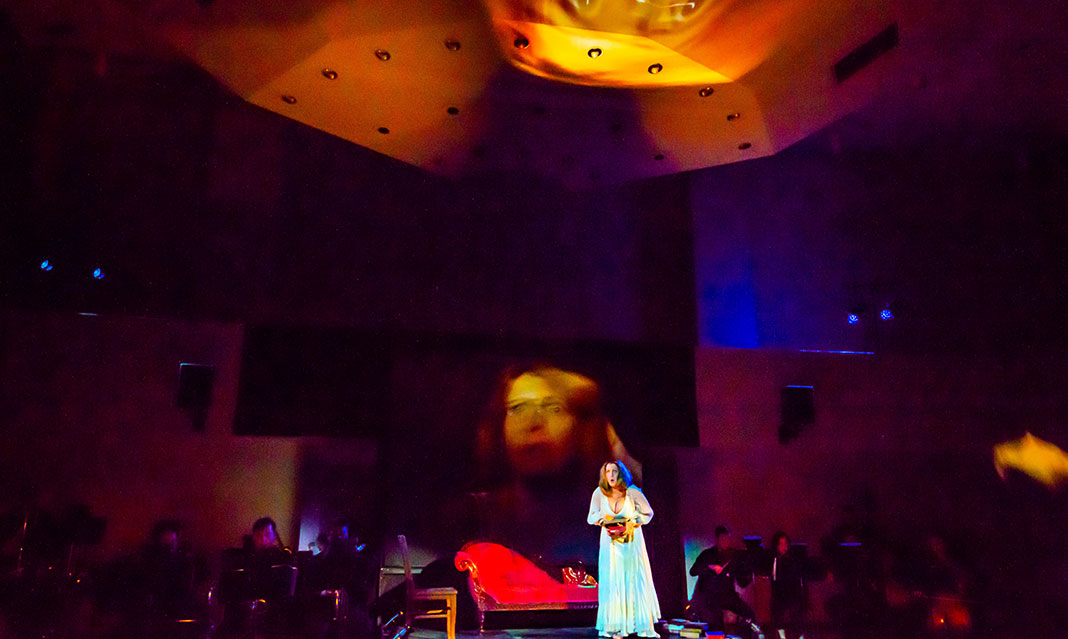Last Thursday, the University of Toronto’s Faculty of Music held a multidisciplinary performance of Toshio Hosokawa’s The Raven based on the original poem by Edgar Allan Poe. A well-known piece of writing is combined with concepts from Japanese Noh theatre, modern notions of film, and the beautiful art of opera. The show was a truly unique and captivating experience of storytelling.
Wallace Halladay, the producer, greeted the audience with a smile inspired by passion. He told us the story of how he developed a “strange love affair with opera” motivated by his grandmother’s interest of the art. Seeing Halladay’s excitement about the performance brought about a roar of applause from the room full of people of all ages.
As the lights dimmed and the show began, I wasn’t sure where to look. On the darker parts of the stage, the orchestra was seated in rows on either side of the centre, where the performer Krisztina Szabó in a long white dress lay on a red couch surrounded by books on the floor and one wooden chair. Behind the couch was a screen projecting video, and in the middle of the audience was Gregory Oh, the conductor. At the farthest back of the stage, I could see other members of the creative and technical team working on video and lighting.
The orchestra provided theatrical sound effects, like water and wind, as well as sinister-seeming tracks that aided Szabó’s performance, but the orchestra also played as a character at times—more specifically, the Raven. At some points, the music was an auditory aid to the performance, and at other points, there was an interaction between music and performer that created the sense of a “mesmerizing psychodrama,” which the show intended. Szabó seemed as though she was speaking to the sounds, music, and the air and space between her eyes and the audience. I was impressed with her ability to ignore the audience sitting directly in front of her and just embrace her role in full.
Having opera be the main method telling the story allowed Szabó to truly embrace the emotion of the performance. Although she combined recitation as well as singing, she used her mezzo-soprano voice to depict weeping or screaming in a beautiful and touching way. Although before she began to sing, the first thing I noticed about Szabó was how expressive her face is. She had all the musical and theatrical support she needed to convey her message, yet her facial expressions are what really added to the emotional effect. It was an image of deep grief and paranoia.
As someone rather familiar with the original poem, it was fascinating to see the words be free from the page and come to life on the stage—and not just on the stage, but on the ceiling too. The video projection behind Szabó was accompanied by occasional projections on the ceiling above the stage, creating a wider view of the story.
I felt that all the different aspects of the performance came together to do one thing: display the character’s internal fight with insanity.
As time went on, the emotion grew stronger. Szabó’s voice got louder. The orchestra played a bigger role. The insanity grew. Szabó moved books around, took her hair out of its tie, gripped her fingers into her scalp, waved her arms around, and tossed the chair across the stage. I was captivated by the repetition of “nevermore!” as it comes at the end of nearly every stanza. Even if you weren’t familiar with the poem or didn’t understand the story being told, it was easy to be emotionally moved by the scene taking place on the stage.
For more of an explanation, I turned to the pamphlet handed out before the show. In the notes section, Paramita Nath, the stage director, explains how Hosokawa was inspired by Japanese Noh theatre. Poe’s famous poem is originally about “a man who descends into madness as he converses with a raven over the death of his beloved Lenore,” writes Nath. Hosokawa thought of “Japanese Noh plays because of [The Raven’s] similarly anthropocentric viewpoint,” meaning that characters in Noh plays are usually animals, plants, and unearthly spirits. For this production, having a “mezzo-soprano interpret the part of the narrator (instead of a man as in the original poem), [Hosokawa] purposely revers the usual order of a Noh play (in which women’s roles are traditionally played by men) to broaden the theme to feelings of loss in general,” writes Nath.
The performance was an incredible experience, allowing the audience to see what it is like in the mind of Poe’s narrator in an inimitable production. My favourite part was watching the conductor guide the orchestra as well as Szabó, as if she herself was an instrument.



